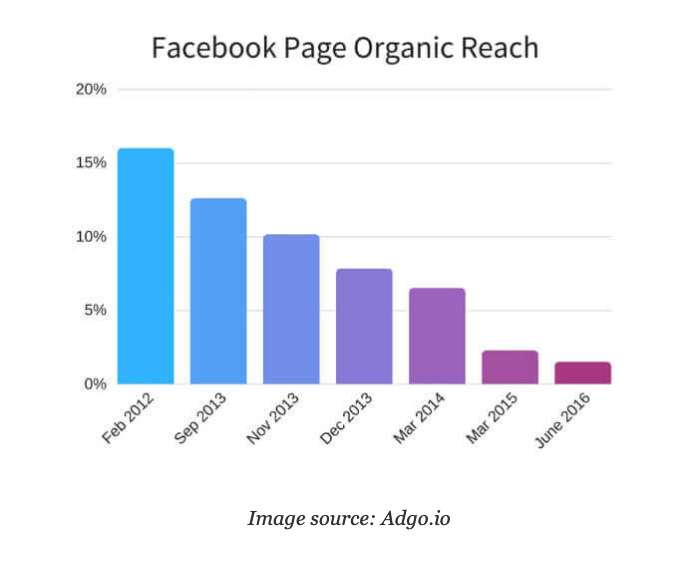
How to Bring Your Dying Organic Social Media Content to Life
Ah, ha, ha, ha, stayin’ alive, stayin’ alive!
The effectiveness of organic social media has been dying for the better part of the last five years, and it’s going to take more than a catchy song from the ‘70s to bring it back to life.
If your business has noticed a decline in organic social media reach, you’re not alone. With recent pushes by Facebook to prioritize content from family and friends, content from auto dealers and other businesses is left unseen.
There is still a place for organic social media in your digital marketing strategy, but it should look different today than it did five years ago.
Learn what you should incorporate into your organic social media strategy to improve the overall effectiveness of your digital marketing efforts.
How Organic Content Differs from Paid Advertising
Simply put, posting content organically on social media platforms refers to content that has no money behind it. This is how all content was posted on Facebook until 2007, when Facebook introduced paid advertising on the platform.
Paid advertising, on the other hand, is just as it sounds: building an ad with an assigned budget that is delivered to an audience based on the targeting parameters you set.
While posting organically is nice in that in costs you nothing, most businesses that utilize social media marketing have seen the success that paying for ad space has in achieving their marketing goals.
Why Organic Social Media Is Dying
In addition to the successful effect of paid advertising on Facebook and other social media platforms, there are more reasons why organic social media is dying.
Since 2012, organic reach on Facebook has been slowly declining. In 2016, it reached its lowest point ever (and has only continued to drop).

Leading up to the highly contentious U.S. presidential election in 2016, many Facebook users were sharing political news (both legitimate and illegitimate) that made the platform an unpleasant place to be.
In light of the negative publicity and user experience, Facebook made an update to its algorithm that prioritized content from family and friends rather than news outlets and other businesses.
In 2018, Facebook reemphasized this commitment by reducing the exposure of the organic feed and going all in on a people-first focus. It’s estimated that only about 6% of your business’s Facebook audience actually sees your content in their news feeds.
This means that if your auto dealership’s Facebook page has 1,000 likes, only about 60 people will actually see the content. (If the post is popular and gets great engagement, including many likes and shares, your organic reach may be greater.)
3 Ways to Improve Your Organic Social Media Strategy
Posting organically on social media is still important for building up your brand’s image, but with the continuous decline in organic reach, you’ll want to do everything you can to make the most of every post.
Here are three tactics you can use to boost your online organic reach.

1.Incorporate Video
For years, Facebook has encouraged more use of video content throughout the platform. It will often show videos ahead of regular posts in the news feed.
The content you record for videos doesn’t need to be brand new. Repurpose old blog posts and emails, and turn them into short video clips you can share over time across your social media channels.
Here are a few additional pointers for adding video content to your organic social media strategy:
- Add captions to your videos.
- Make your videos short (30 seconds or fewer) and to the point.
- Eliminate outside noises when possible.
- Record video horizontally instead of vertically.
You can record video content on your iPhone or even hire a professional videographer to film your content. Whatever you decide, sprinkling video content throughout your social media channels will most likely increase your organic reach and engagement.

2. Use Hashtags
The use of hashtags in social media content has been around for more than a decade, but one could argue that incorporating hashtags into organic social content is even more important now than it was five years ago.
Hashtags are a way to for people who don’t like your Facebook page or follow you on Twitter or Instagram to discover your content.
When a user clicks on or searches for a hashtag in Facebook, Twitter, or Instagram, content from people and businesses using that hashtag will appear. This allows the user to discover posts from accounts they might not already follow and to educate themselves more about the hashtag topic.
Hashtags are proven to increase organic engagement across social media platforms. So just how much more engagement is possible when you use hashtags? Here are some helpful statistics:
- Facebook: A post with one or two hashtags will receive, on average, 177 more interactions than posts without hashtags.
- Twitter: Incorporating hashtags in your tweets extends the life of your tweet (which is only about 15 minutes without hashtags) and will continue to keep your tweets #relevant.
- Instagram: Posts with hashtags receive 12% more engagement than posts without hashtags.
Need help figuring out which hashtags you should be incorporating into your social content? See our hashtag tips and tricks in this post.
3. Focus on Your Own Assets
Quality over quantity should be your mindset whenever you post on social media. While sharing a funny cat video may get your post a few likes and comments, is it really educating people about your business and driving traffic to your website? Probably not.
Posting and sharing mediocre content 10 times a day isn’t going to give your business an edge compared to a business that posts quality content that promotes engagement twice a week.
Take the time to build up good blog posts, landing pages, and additional helpful resources on your own website.
This evergreen content can be shared over and over on social media and will hopefully promote engagement while bringing users to your own website. Plus, this type of content will give you a boost when it comes to SEO.
Pay to Play with Facebook Ads
Incorporating the three steps into your organic social media strategy may increase your organic reach and engagement, but it still won’t be enough to capture the online leads you need.
Facebook ads allow you to show the right message at the right time to the right audience, engaging customers at their personal stage of the sales funnel. Plus, you can measure ROI on Facebook ads, which is much more difficult to do when posting organically alone.
The decline of organic social media was the topic of one of our webinars, “Organic Social Is Dead: 5 Better Ways to Reach Leads Online.” Learn how to improve your organic social media strategy by watching this free webinar!

Find the Right Combination with 9 Clouds
Any good business will have the right combination of paid advertising and organic social media content in its digital marketing strategy.
Need help figuring out that balance? We can help! Talk digital strategy and online advertising with 9 Clouds, and check out our latest organic social media webinar!


![Human vs AI A/B Test [Spoiler Alert: Humans Win!]](https://9clouds.com/wp-content/uploads/2024/02/Volvo-dealership-1-600x388.png)


